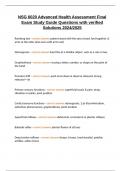NSG 6020 Advanced Health Assessment Final
Exam Study Guide Questions with verified
Solutions 2024/2025
Romberg test - correct answer patient stand with the eyes closed, feet together, &
arms at the sides (also seen with arms out)
Stereognosis - correct answer hand the pt a familiar object, such as a coin or key
Graphesthesia - correct answer tracing a letter, number, or shape on the palm of
the hand
Pronator drift - correct answer push arms down & observe rebound; strong
rebound = ok
Primary sensory functions - correct answer superficial touch & pain; temp,
vibration on joints, joint position
Cortical sensory functions - correct answer stereognosis, 2 pt discriminication,
extinction phenomenon, graphesthesia, point location
Superficial reflexes - correct answer abdominal, cremasteric & plantar reflexes
Babinski reflex - correct answer plantar flexion of all toes
Deep tendon reflexes - correct answer biceps, triceps, brachioradial, patellar,
achilles, ankle clonus
,Protective sensation - correct answer 5.07 monofilament for neuropathy
Meningeal signs - correct answer checking for a stiff neck with the supine
patient's head raised & by eliciting Brudzinski sign & Kernig sign
Patellar deep tendon reflex - correct answer spinal segments L2, L3, & L4
Autonomic dysreflexia - correct answer severe HTN caused by dysregulation of
sympathetic & parasympathetic nervous systems reacting to a noxious stimulus
(tight; foley) below the site of spinal injury
Autonomic dysreflexia other sx - correct answer bradycardia, anxiety, blurred
vision, headache, flushing, & sweating.
Cerebellum - correct answer smooth & accurate coordination of voluntary
movements
What are the abnormal findings when testing Cranial nerve I (olfactory)? - correct
answer inability to perceive an odor on either side, anosnia (loss of smell), & the
inability to discriminate odors.
What are the abnormal findings when testing Cranial nerve II (optic)? - correct
answer abnormal fundi exam with opthalmoscope & problems with distant or
near vision.
What are the abnormal findings when testing cranial nerve III, IV, & VI? - correct
answer abnormal pupillary response, drooping eyelid, abnormal extraocular
movements, problems with consensual pupillary response.
,What are the abnormal findings when testing cranial nerve V (trigeminal)? -
correct answer facial atrophy, facial tremors, decreased tone & strength in the
jaw, inability to discern pain in each branch or touch, absent corneal reflex.
What are the abnormal findings when testing cranial nerve VII (facial)? - correct
answer asymmetrical facial features, inability to taste salty or sweet.
What are the abnormal findings when testing cranial nerve VIII (acoustic)? -
correct answer bone or air conduction hearing deficit, lateralization of sound with
Weber test, inability to hear whispers.
What are the abnormal findings when testing cranial nerve IX (glossopharyngeal),
& X (vagus)? - correct answer Inability to taste sour or bitter on either side of the
tongue, absent gag reflex, inability to swallow, asymmetry in uvula with speech,
gutteral speech sounds.
What are the abnormal findings when testing cranial nerve XI (spinal accessory)? -
correct answer cannot shrug shoulders against resistance, cannot turn head side
to side against resistance.
What are the abnormal findings when testing cranial nerve XII (hypoglossal)? -
correct answer protruded tongue is not symmetrical, tremors, atrophy. Tongue
does not move up towards nose or down towards chin, test tongue strength with
index finger when tongue is pressed against the cheek (weakness), evaluate
lingual speech (l, t, d, n).
How do you evaluate proprioception? - correct answer through coordination, fine
motor skills, and balance.
, What are some proprioception coordination tests? - correct answer rapid
rhythmic alternating movements such as thumb to fingers as quickly as possible ,
the finger-to-nose test, & the heel-to-skin test.
How is balance evaluated? - correct answer with the Romberg test, fast recovery
of balance when shoved, eyes closed standing on one foot, hopping in place on
one foot then the other.
What is the Romberg test? - correct answer ask patient (with eyes open then
closed) to stand, feet together & arms at the side. Stand close, prepared to catch
them. Loss of balance is a positive Romberg sign.
What does a positive Romberg sign mean? - correct answer indicates cerebellar
ataxia, vestibular dysfunction or sensory loss.
What is the cerebellum responsible for? - correct answer voluntary movement,
sensory information processing, reflexive control of muscle tone, balance, and
posture to produce steady and precise movements.
What are possible differential diagnoses for abnormal cerebellar functioning? -
correct answer cerebellar ataxia (cerebellitis) affects gait & balance. Can be
caused by chicken pox, Epstein- Barr, & coxsackie viruses.
How do you evaluate sensory function? - correct answer evaluate both primary &
cortical discriminatory sensation by having the pt identify various sensory stimuli
at the following sites: hands, lower arms, abdomen, feet, and lower legs.
How is each sensory discrimination procedure tested? - correct answer with the
patient's eyes closed, test side to side.




